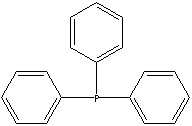PRODUCT IDENTIFICATION

H.S. CODE
2931.00.9999
TOXICITY
CLASSIFICATION
Organophosphines / tertiary phosphine
PHYSICAL AND CHEMICAL PROPERTIES
MELTING POINT
SOLUBILITY IN WATER
REFRACTIVE INDEX
181
GENERAL DESCRIPTION & EXTERNAL LINKS
Phosphine, also called Hydrogen Phosphide, PH3, is a colourless, poisonous, spontaneously flammable gas, with a disagreeable, garlic-like odour; melting point -133.5 C, boiling point -87.4 C. Phosphine is manufactured by the hydrolysis of metal phosphides, by the electrolysis of phosphorus in the presence of hydrogen, or by the phosphorus-steam reaction. Phosphine has the structure of ammonia (NH3) but with phosphorus in place of nitrogen. It is slightly soluble in cold water and soluble in alcohol. Phosphine is less soluble in water than ammonia. Phosphine is used in the synthesis of organophosphines and phosphonium derivatives and as a dopant in the manufacture of semiconductors. Aluminium or magnesium phosphide are used as formulations prepared for fumigation in pest control, and zinc phosphide is used as a rodenticide. Phophene is a starting material for the preparation of pesticides and flame retardants. Organophosphines are used as solvents for the extraction and separation processes, flame retardants, and in formulating fumigants and electronics applications of semiconductor manufacturing. Tertiary alkylphosphines act as chemical intermediate and catalyst in the production of industrial acids, alcohols, flavors & fragrances, and pharmaceuticals. Phosphonium describes a univalent radical, PH4. Quaternary phosphonium salts, obtained from tertiary alkylphosphines with the treatment with alkyl or aromatic halides, are replacing phase transfer catalysts and biocides functions for quaternary ammonium salts due to more effective performance and higher thermal stability. Phosphonium salts are used as epoxy curing agents. A variety of phosphine transition metal complexes including chiral complexes are synthesized as the very reactive and versatile homogeneous catalysts and stereospecific as well. Triphenylphosphine is used as a catalyst for organic synthesis, intermediate for phase transfer catalysts and Wittig reactions.
Wikipedia Linking: http://en.wikipedia.org/wiki/Triphenylphosphine
http://www.sigmaaldrich.com
Molecules
containing a tertiary phosphine have played an important role in
the development of organic reactions, predominantly in catalysis.
The electronic and steric properties of these molecules have made
them a prime choice for the synthesis of ligands that are used in
the design of metal-based catalysts. Furthermore, they stabilize
a wide variety of metal complexes and are relatively inert to many
reaction conditions. These properties can be systematically tuned
with predictable results. They are used in a variety of catalytic
reactions such as cross-coupling and asymmetric synthesis........
APPEARANCE
ASSAY
99.0% min
78.5 C min
RESIDUE ON IGNITION
1.0% max
0.01% max